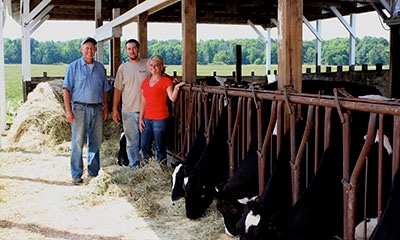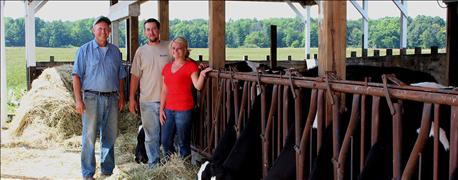September 22, 2016

While members of the Wolff family have farmed along Wolff Road in Medina County since 1875, these days the road is populated with more nonfarmers than farmers. Despite the population growth that surrounds them, Lowell Wolff, son Justin, and Justin’s wife, Kara, are committed to keeping their land in agriculture and preserving the natural resources that make the land productive.
“The natural resources are here to provide for us, but we need to be good stewards to preserve them for future generations,” Lowell says.

The Wolff family is being recognized for their efforts with a 2016 Ohio Conservation Farm Family Award.
The family is being recognized for their efforts with a 2016 Ohio Conservation Farm Family Award. Their 250-acre farm includes a 95-cow Holstein dairy, as well as about 150 acres of crop production, 36 acres of hay and 25 acres of pasture. They also have 40 acres of managed woodland.
The Wolffs generally follow a seven-year crop rotation with corn followed by soybeans, and then another year of corn followed by wheat. After wheat harvest they plant hay, which is usually kept in place for three years. In addition, they plant cover crops after harvesting soybeans and corn silage. “I like to keep things covered up as much as possible,” Justin says.
Justin is the sixth generation in the Wolff family to milk cows on the farm. Lowell previously ran the dairy while working as a high school ag teacher for 35 years. He retired from teaching two years ago and continues to help with farm chores.
Kara works off the farm for the Dairy Farmers of America co-op, but still finds time to help with milking and other farm chores. In addition, she raises a large garden along with another grower who supplies produce to local restaurants.
The Wolffs farm heavy clay soils that can be very productive if they are well managed, but they’re unforgiving of poor management. Soil erosion and nutrient runoff are concerns on the farm’s gently sloped fields.
Crop rotations that include cover crops, wheat and forages help protect the ground and improve the soil tilth. The Wolffs use no-till for soybeans, but they prefer conservation tillage for corn because of the heavy, wet soils. They also incorporate manure to work in nutrients.
In 2009, they built a sand-bedded freestall barn, along with a covered manure storage facility. That lets them store manure for up to six months, Justin says.
“We can wait for that right time; it’s better for the ground.” They apply manure and other nutrients based on soil test results to avoid overapplication.
Water protection a priority
Another conservation practice installed at the dairy is a milk house wastewater system that diverts wash water into a settling tank and then into a sprinkler system. After solids settle out, the water is used to irrigate pastureland, explains Justin.
During the growing season, cattle have access to permanent pasture; however, they are fed a total mixed ration year-round to support production. In past generations, cattle were pastured in woodlots, but they are now fenced out to protect the woodlands.
The Wolffs also maintain a wet area adjacent to the woods by mowing it after the nesting season to prevent overgrowth of trees and multiflora rose. The land isn’t well suited for ag production, so it is maintained as grassland, Kara says. “It works out best for nature and for us.”
The Wolffs have protected an erodible stream with pine tree plantings, and they’ve planted dozens of additional trees around the farm to replace naturally aging trees and those killed by emerald ash borers. “Every time I turn around there’s a new flag,” says Kara.
To connect with their nonfarm neighbors, the Wolffs opened their farm for tours, including the Medina County Fall Foliage Tour last year. The annual event rotates among four different areas and attracts hundreds of participants.
During the tour, the Wolffs posted information about the history of the farm and how cows are cared for. Visitors were able to watch cows being milked, visit barns and ask questions.
“We let them have free range,” Kara says. “It’s great for the community because so many people are so far removed from the farm and are curious about where their food comes from.”
It’s important for farmers to be involved with their communities, helping the public understand the importance of farms and farmland, notes Lowell. “People see open land and they don’t realize the value agriculture brings to the community.”
For instance, on average, for every $1 a home pays in property tax, the community must provide $1.40 worth of community services such as schools and fire protection, Lowell explains. Farmland, however, even with reduced tax rates provided by current agricultural-use valuation requires only about 40 cents in services for each $1 paid in taxes. “Farmland is a net profit, tax-wise,” he says.
Too often, communities develop farmland rather than redeveloping blighted urban areas that already have infrastructure in place, Lowell says. “Somehow we need to get better land-use policies in this country.”
Another concern is that the world currently has about a half acre of tillable land per person. But as the population grows and nonfarm development replaces farmland, the world will have even less land available to feed each person, Lowell points out. Producing food is not the only important function of farmland, Lowell adds. “The quality of life it provides — emotionally and spiritually — that’s irreplaceable.”
You May Also Like




